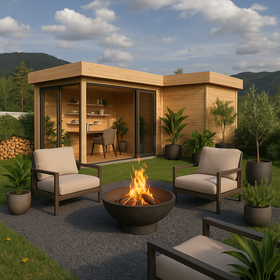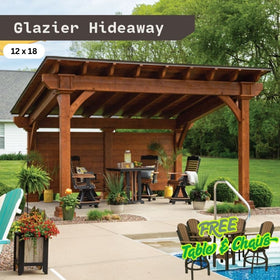512-777-0154

Tiny Home Versus Mobile Home: Guide to Cost, Zoning, and Lifestyle
Tiny home versus mobile home: what’s the real difference? Short answer: tiny homes are compact and charming; mobile homes offer more space and comfort. Both are affordable alternatives to traditional houses. Both offer freedom in their own way. Yet they carry different expectations and very different day-to-day experiences.
This guide breaks everything down in a way that’s simple, helpful, and realistic.
Understanding the Fundamentals
Before comparing features, it helps to be clear about what each type of home actually is. A lot of people mix them up, but the differences matter.
Defining the Mobile Home (Manufactured Home)
A mobile home is built in a factory and follows strict national building rules known as the HUD Code. Once built, it’s delivered to a homesite and set up in one or more sections.
These tiny homes usually offer plenty of space. You get real rooms, full-size appliances, and layouts that feel familiar. They can be moved again, but doing so takes a crew and a chunk of money, so most people keep them in one spot for years.
Defining the Tiny Home
A tiny home is built with one goal in mind. Live small. Live simply.
Most tiny homes stay under 400 square feet. Some sit on trailers, which lets owners relocate when needed. Others rest on foundations and act more like traditional cottages. These homes lean heavily on clever storage, multipurpose furniture, and a mindset that values what matters and lets the rest go.
Head-to-Head Comparison: 7 Core Differences
Each home shines in different ways. Here’s what separates one from the other when you look closely.
1. Size and Usable Interior Space
Tiny homes squeeze a lot into a small footprint. Lofts, fold-down tables, hidden storage. Every inch works overtime. They feel cozy and personal, but space is limited.
Mobile homes come with far more room. You get proper bedrooms, a living area that fits real furniture, and kitchens that don’t require mini appliances. Families usually find mobile homes easier to live in long-term.
2. Cost, Price, and Financing
Tiny homes often start at a lower price. Many DIY builds fall between twenty and fifty thousand dollars. Custom builds can climb higher. Financing can be tricky because lenders may classify them as RVs or personal property.
Mobile homes vary widely in cost. A single-wide can be affordable, while larger models can cost more than one hundred thousand dollars. The upside is better access to financing that feels closer to a standard mortgage.
3. Mobility and Relocation
Tiny homes on wheels make moving simple compared to other home types. Owners can tow them or hire someone to move them. They’re built with travel in mind.
Mobile homes can move, too, but the process is slow and pricey. Think of it as a one-time move rather than a lifestyle feature.
4. Regulations, Codes, and Zoning
Tiny homes face the toughest rules. Some cities limit where you can place them. Others only allow them in RV parks or communities created specifically for tiny living.
Mobile homes follow national construction rules, which makes placement more predictable. Many cities already have zones or parks set aside for them.
5. Depreciation vs. Appreciation (Value Over Time)
Mobile homes often lose value over time, especially if they sit on rented land. Homes placed on land you own tend to hold value longer.
Tiny homes are harder to predict. Some sell quickly because buyers love unique designs. Others lose value if zoning rules make placement difficult. The market is still young, which means trends change often.
6. Construction and Durability
Tiny homes vary based on who builds them. Some builders use high-end materials and sturdy craftsmanship. Others focus on keeping the home lightweight, which can limit what they can include.
Mobile homes follow a consistent national code that sets clear rules for quality. Heating, cooling, and safety features stay fairly standard across the board.
7. Lifestyle and Aesthetic
Tiny homes attract people who want a slower, simpler lifestyle. Owners often enjoy the charm, the creativity, and the intentional way of living that comes with less space.
Mobile homes feel more traditional. They’re practical, comfortable, and familiar. Many people choose them when they want affordable living without giving up everyday conveniences.
The Pros and Cons of Each Option
Choosing a home is never just about the price tag or the square footage. It’s about how you want to live day to day. Both tiny homes and mobile homes come with clear strengths and a few challenges.
Looking at the pros and cons side by side makes the decision a whole lot easier. Here’s what to expect from each option.
Tiny Home: Weighing the Benefits and Drawbacks
Pros
- Lower entry cost
- Easy to move
- Stylish and customizable
- Low utilities
- Encourages simple living
Cons
- Very limited storage
- Harder zoning rules
- Financing challenges
- Uncertain resale value
- Tight for families
Mobile Home: The Upsides and Disadvantages
Pros
- More space
- Easier zoning
- Better financing options
- Built to a national standard
- Comfortable for families
Cons
- Can lose value
- More repairs over time
- Expensive to relocate
- Park rules and fees
- Less design flexibility
Making the Best Financial and Lifestyle Choice
Choosing between a tiny home and a mobile home comes down to how you want to live. If you want freedom to move and a lifestyle that stays simple, a tiny home fits that mindset. If you want more space, easier financing, and predictable comfort, a mobile home is the stronger fit.
Both offer affordable paths to housing. The best choice is the one that matches your priorities, your budget, and the way you want your daily life to feel.
You may also like:
- Where Can I Put a Tiny Home?
- Are Tiny Homes Worth It? Breakdown of Costs, Lifestyle, and Legality
- What Type of Foundation is Best for Tiny Homes? Options, Costs, and Building Requirements
- Micro Homes vs. Tiny Homes: Comparison of Size, Cost, and Legal Limits
- How to DIY a Tiny Home: Guide to Building, Plans, and Budgeting







